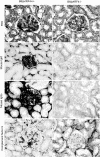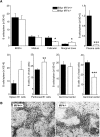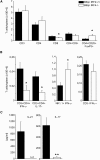IRF4 deficiency abrogates lupus nephritis despite enhancing systemic cytokine production
- PMID: 21742731
- PMCID: PMC3148699
- DOI: 10.1681/ASN.2010121260
IRF4 deficiency abrogates lupus nephritis despite enhancing systemic cytokine production
Abstract
The IFN-regulatory factors IRF1, IRF3, IRF5, and IRF7 modulate processes involved in the pathogenesis of systemic lupus and lupus nephritis, but the contribution of IRF4, which has multiple roles in innate and adaptive immunity, is unknown. To determine a putative pathogenic role of IRF4 in lupus, we crossed Irf4-deficient mice with autoimmune C57BL/6-(Fas)lpr mice. IRF4 deficiency associated with increased activation of antigen-presenting cells in C57BL/6-(Fas)lpr mice, resulting in a massive increase in plasma levels of TNF and IL-12p40, suggesting that IRF4 suppresses cytokine release in these mice. Nevertheless, IRF4 deficiency completely protected these mice from glomerulonephritis and lung disease. The mice were hypogammaglobulinemic and lacked antinuclear and anti-dsDNA autoantibodies, revealing the requirement of IRF4 for the maturation of plasma cells. As a consequence, Irf4-deficient C57BL/6-(Fas)lpr mice neither developed immune complex disease nor glomerular activation of complement. In addition, lack of IRF4 impaired the maturation of Th17 effector T cells and reduced plasma levels of IL-17 and IL-21, which are cytokines known to contribute to autoimmune tissue injury. In summary, IRF4 deficiency enhances systemic inflammation and the activation of antigen-presenting cells but also prevents the maturation of plasma cells and effector T cells. Because these adaptive immune effectors are essential for the evolution of lupus nephritis, we conclude that IRF4 promotes the development of lupus nephritis despite suppressing antigen-presenting cells.
Figures








Similar articles
-
IL-12 deficiency in MRL-Fas(lpr) mice delays nephritis and intrarenal IFN-gamma expression, and diminishes systemic pathology.J Immunol. 2003 Apr 1;170(7):3915-25. doi: 10.4049/jimmunol.170.7.3915. J Immunol. 2003. PMID: 12646661
-
Piperlongumine alleviates lupus nephritis in MRL-Fas(lpr) mice by regulating the frequency of Th17 and regulatory T cells.Immunol Lett. 2014 Sep;161(1):76-80. doi: 10.1016/j.imlet.2014.05.001. Epub 2014 May 14. Immunol Lett. 2014. PMID: 24837470
-
CXCR3 mediates renal Th1 and Th17 immune response in murine lupus nephritis.J Immunol. 2009 Oct 1;183(7):4693-704. doi: 10.4049/jimmunol.0802626. Epub 2009 Sep 4. J Immunol. 2009. PMID: 19734217
-
Mediators of inflammation and their effect on resident renal cells: implications in lupus nephritis.Clin Dev Immunol. 2013;2013:317682. doi: 10.1155/2013/317682. Epub 2013 Sep 22. Clin Dev Immunol. 2013. PMID: 24171032 Free PMC article. Review.
-
Pathogenesis of lupus nephritis: the contribution of immune and kidney resident cells.Curr Opin Rheumatol. 2023 Mar 1;35(2):107-116. doi: 10.1097/BOR.0000000000000887. Epub 2022 Jul 5. Curr Opin Rheumatol. 2023. PMID: 35797522 Review.
Cited by
-
Protein phosphatase 2A enables expression of interleukin 17 (IL-17) through chromatin remodeling.J Biol Chem. 2013 Sep 13;288(37):26775-84. doi: 10.1074/jbc.M113.483743. Epub 2013 Aug 5. J Biol Chem. 2013. PMID: 23918926 Free PMC article.
-
IFN Regulatory Factor 4 Controls Post-ischemic Inflammation and Prevents Chronic Kidney Disease.Front Immunol. 2019 Oct 1;10:2162. doi: 10.3389/fimmu.2019.02162. eCollection 2019. Front Immunol. 2019. PMID: 31632388 Free PMC article.
-
EAF2 deficiency attenuates autoimmune disease in Fas lpr mice by modulating B cell activation and apoptosis.iScience. 2024 Oct 21;27(11):111220. doi: 10.1016/j.isci.2024.111220. eCollection 2024 Nov 15. iScience. 2024. PMID: 39555413 Free PMC article.
-
The multiple roles of interferon regulatory factor family in health and disease.Signal Transduct Target Ther. 2024 Oct 9;9(1):282. doi: 10.1038/s41392-024-01980-4. Signal Transduct Target Ther. 2024. PMID: 39384770 Free PMC article. Review.
-
Transcription Factors in the Pathogenesis of Lupus Nephritis and Their Targeted Therapy.Int J Mol Sci. 2024 Jan 16;25(2):1084. doi: 10.3390/ijms25021084. Int J Mol Sci. 2024. PMID: 38256157 Free PMC article. Review.
References
-
- Kotzin BL: Systemic lupus erythematosus. Cell 85: 303–306, 1996 - PubMed
-
- Goodnow CC: Multistep pathogenesis of autoimmune disease. Cell 130: 25–35, 2007 - PubMed
-
- Kanta H, Mohan C: Three checkpoints in lupus development: Central tolerance in adaptive immunity, peripheral amplification by innate immunity and end-organ inflammation. Genes Immun 10: 390–396, 2009 - PubMed
-
- Theofilopoulos AN, Baccala R, Beutler B, Kono DH: Type I interferons (alpha/beta) in immunity and autoimmunity. Annu Rev Immunol 23: 307–336, 2005 - PubMed
Publication types
MeSH terms
Substances
LinkOut - more resources
Full Text Sources
Research Materials
Miscellaneous

